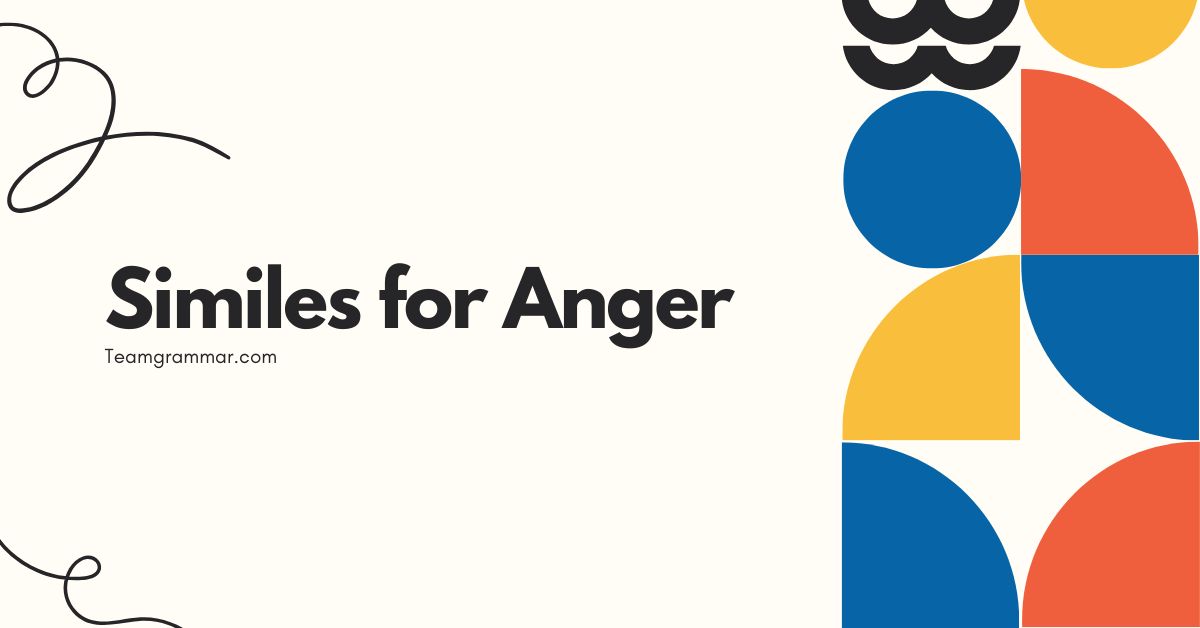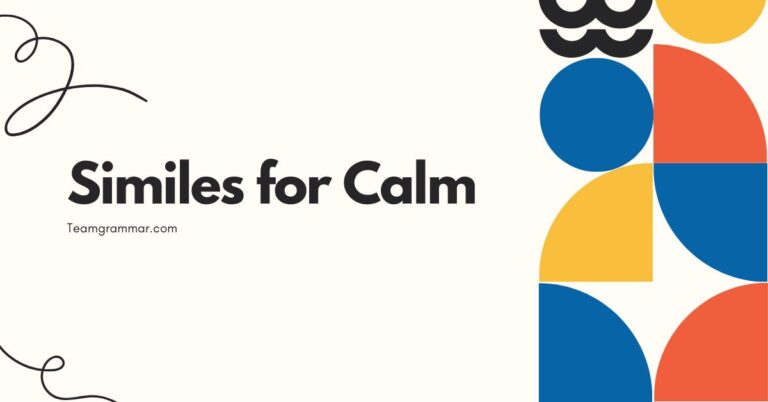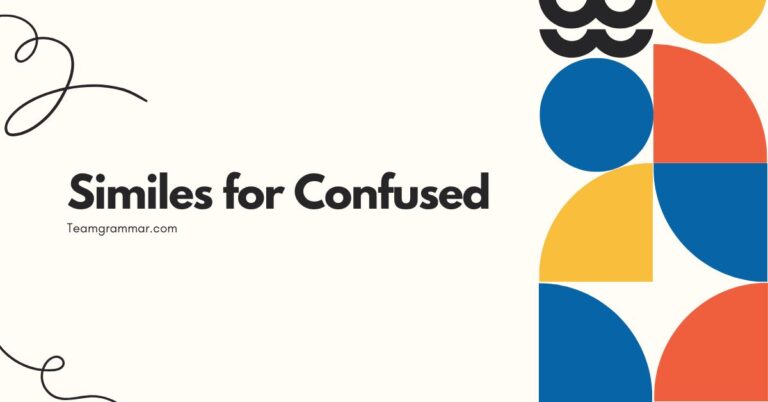31 Similes for Anger: Mastering Figurative Language
Understanding similes is crucial for enhancing your descriptive writing and comprehension skills. Similes, which use “like” or “as” to compare two unlike things, add vividness and depth to language.
This article focuses specifically on similes used to describe anger, providing you with the tools to express this powerful emotion in creative and impactful ways. Whether you’re a student, writer, or language enthusiast, this guide will equip you with a comprehensive understanding of similes for anger, improving your overall command of the English language.
Table of Contents
- Definition of Simile
- Structural Breakdown of Similes
- Types of Anger Similes
- Examples of Similes for Anger
- Usage Rules for Similes
- Common Mistakes with Similes
- Practice Exercises
- Advanced Topics in Similes
- Frequently Asked Questions
- Conclusion
Definition of Simile
A simile is a figure of speech that compares two unlike things using the words “like” or “as.” Its primary function is to create a vivid and relatable image in the reader’s mind by drawing a parallel between something familiar and something less so. Similes are essential tools for writers to enhance their descriptions and convey emotions more effectively.
Unlike metaphors, which directly equate two things, similes acknowledge the difference while highlighting a similarity.
In the context of describing anger, similes help to articulate the intensity and characteristics of this emotion by comparing it to tangible objects, forces of nature, or animal behaviors. This allows the writer to paint a more vibrant and understandable picture of the anger being portrayed.
The use of similes can transform a simple statement of anger into a powerful and evocative description.
Structural Breakdown of Similes
The basic structure of a simile includes two main components: the subject being described (in this case, anger) and the object it is being compared to, connected by the words “like” or “as.” Understanding this structure is key to creating and interpreting similes effectively. The comparison highlights a shared characteristic or quality between the two elements.
A typical simile follows the pattern:[Subject] + [linking word (“like” or “as”)] + [Object]. For example, “His anger was like a volcano erupting.” Here, “His anger” is the subject, “like” is the linking word, and “a volcano erupting” is the object being compared to.
The implied similarity is the sudden, forceful, and destructive nature of both anger and a volcanic eruption.
Identifying the Components
To properly analyze a simile, it’s crucial to identify each component: the subject (the thing being described), the linking word (like or as), and the object of comparison (the thing the subject is being compared to). Once these are identified, you can understand the intended meaning and the quality being emphasized.
For example, in the simile “She was as mad as a hornet,” “She” is the subject (the angry person), “as” is the linking word, and “a hornet” is the object of comparison. The shared quality being highlighted is the intense, stinging, and aggressive nature of both the person and the hornet.
Implicit and Explicit Comparisons
While most similes are explicit, clearly stating the comparison using “like” or “as,” the quality being compared can be either explicit or implicit. In an explicit comparison, the shared quality is stated directly.
In an implicit comparison, the shared quality is implied and requires the reader to infer the connection.
Explicit Comparison Example: “His anger was like a raging fire, consuming everything in its path.” (The consuming nature is explicitly stated.)
Implicit Comparison Example: “He was as furious as a storm-tossed sea.” (The turbulence and chaos are implied, requiring the reader to connect these qualities to anger.)
Types of Anger Similes
Similes for anger can be categorized based on the type of object or concept used for comparison. These categories include comparisons to natural phenomena, animals, objects, and abstract concepts.
Each category offers a unique way to illustrate different aspects of anger.
Natural Phenomena
These similes compare anger to forces of nature, like storms, volcanoes, or earthquakes. They emphasize the uncontrollable, powerful, and destructive aspects of anger.
These comparisons often evoke a sense of overwhelming force and intensity.
Animal Comparisons
Animal similes draw parallels between anger and the behavior or characteristics of certain animals, such as lions, snakes, or wasps. These comparisons can highlight the aggressive, defensive, or venomous qualities of anger.
They often create a visceral and immediate image.
Object Comparisons
These similes use objects, like pressure cookers, bombs, or tightly wound springs, to represent anger. They focus on the building pressure, explosive potential, or rigid tension associated with anger.
These comparisons often convey a sense of contained or suppressed emotion ready to burst forth.
Abstract Concept Comparisons
Abstract concept similes compare anger to intangible ideas, like darkness, poison, or a disease. They emphasize the destructive, corrupting, or pervasive influence of anger.
These comparisons often convey the deeper, more insidious effects of anger on a person’s well-being.
Examples of Similes for Anger
This section provides extensive examples of similes for anger, organized by the categories discussed above. Each category includes a variety of similes to illustrate the range and versatility of this figurative language technique.
Reviewing these examples will help you understand how to effectively use similes to describe anger in your own writing.
Natural Phenomena Similes
The following table provides examples of similes that compare anger to natural phenomena. These examples illustrate the intense and uncontrollable nature of anger.
| Simile | Explanation |
|---|---|
| His anger was like a volcano erupting. | Suggests a sudden, violent outburst. |
| She was as angry as a storm brewing. | Implies a gradual build-up of anger. |
| His rage was like a hurricane tearing through a town. | Conveys the destructive power of anger. |
| Her fury was as cold as a glacial wind. | Indicates a detached, unforgiving anger. |
| His temper flared like a sudden lightning strike. | Emphasizes the unexpected and shocking nature of his anger. |
| She was as furious as a wildfire spreading rapidly. | Highlights the uncontrollable and expansive nature of her anger. |
| His wrath was like a tsunami crashing onto the shore. | Suggests an overwhelming and destructive force. |
| Her anger simmered like a dormant volcano. | Implies a suppressed anger that could erupt at any moment. |
| His rage was as intense as the midday sun. | Conveys the burning and unbearable nature of his anger. |
| She was as mad as a river overflowing its banks. | Indicates an anger that has exceeded its limits. |
| His anger was like an earthquake shaking the ground. | Suggests a destabilizing and disruptive force. |
| She was as angry as a blizzard raging outside. | Implies a cold, harsh, and relentless anger. |
| His rage was like a desert sandstorm, blinding and suffocating. | Conveys the disorienting and oppressive nature of his anger. |
| Her fury was as deep as an ocean trench. | Indicates a profound and immeasurable anger. |
| His temper flared like a solar flare erupting from the sun. | Emphasizes the sudden and intense release of energy. |
| She was as furious as a tornado tearing through the landscape. | Highlights the destructive and chaotic nature of her anger. |
| His wrath was like a mudslide burying everything in its path. | Suggests an overwhelming and destructive force that leaves nothing untouched. |
| Her anger simmered like a geyser about to explode. | Implies a pent-up anger that is on the verge of eruption. |
| His rage was as intense as the heat of a forest fire. | Conveys the burning and destructive power of his anger. |
| She was as mad as a landslide, unstoppable and devastating. | Indicates an anger that is overwhelming and impossible to control. |
| His anger was like a thunderclap, sudden and shocking. | Suggests a sudden, violent outburst that startles everyone around him. |
| She was as angry as a volcano after years of dormancy. | Implies a long-suppressed anger that finally erupts with immense force. |
| His rage was like a rogue wave, unpredictable and destructive. | Conveys the unexpected and devastating nature of his anger. |
| Her fury was as relentless as a desert wind. | Indicates a persistent and unyielding anger. |
Animal Similes
The following table provides examples of similes that compare anger to animal characteristics or behaviors. These examples illustrate the aggressive and defensive nature of anger.
| Simile | Explanation |
|---|---|
| He was as mad as a hornet. | Suggests a stinging, aggressive anger. |
| She was as angry as a cornered lion. | Implies a defensive and fierce anger. |
| His rage was like a snake ready to strike. | Conveys a hidden, venomous anger. |
| Her fury was as sharp as a hawk’s talons. | Indicates a precise and cutting anger. |
| He was as furious as a bear disturbed from hibernation. | Emphasizes a grumpy and easily provoked anger. |
| She was as angry as a rattlesnake ready to strike. | Highlights the dangerous and threatening nature of her anger. |
| His wrath was like a pack of wolves descending on prey. | Suggests a relentless and predatory anger. |
| Her anger simmered like a cat ready to pounce. | Implies a controlled but imminent outburst. |
| His rage was as intense as a swarm of bees attacking. | Conveys the overwhelming and painful nature of his anger. |
| She was as mad as a caged tiger. | Indicates a trapped and frustrated anger. |
| He was as furious as a bull seeing red. | Emphasizes a blind and uncontrolled rage. |
| She was as angry as a viper hissing in the grass. | Implies a concealed and venomous anger. |
| His rage was like a shark circling its prey. | Conveys a patient but menacing anger. |
| Her fury was as cold as a snake’s skin. | Indicates a calculating and emotionless anger. |
| He was as furious as a hawk diving for its prey. | Emphasizes a swift and decisive anger. |
| She was as angry as a bear protecting its cubs. | Highlights a fiercely protective and defensive anger. |
| His wrath was like a swarm of locusts devouring everything in its path. | Suggests a destructive and insatiable anger. |
| Her anger simmered like a spider waiting in its web. | Implies a patient and predatory anger. |
| His rage was as intense as a lion’s roar. | Conveys the powerful and intimidating nature of his anger. |
| She was as mad as a wounded animal. | Indicates a vulnerable and volatile anger. |
| He was as furious as a pit bull straining at its leash. | Emphasizes a restrained but powerful and aggressive anger. |
| She was as angry as a scorpion with its stinger raised. | Implies a defensive and venomous anger ready to strike. |
| His rage was like a wild horse bucking and kicking. | Conveys an uncontrollable and chaotic anger. |
| Her fury was as unpredictable as a cat’s mood. | Indicates an erratic and temperamental anger. |
Object Similes
The following table provides examples of similes that compare anger to objects. These examples illustrate the contained or explosive nature of anger.
| Simile | Explanation |
|---|---|
| He was like a pressure cooker about to explode. | Suggests a build-up of suppressed anger. |
| She was as angry as a tightly wound spring. | Implies a rigid and tense anger. |
| His rage was like a bomb waiting to detonate. | Conveys the destructive potential of anger. |
| Her fury was as sharp as a broken glass. | Indicates a cutting and painful anger. |
| He was as furious as a rusty hinge refusing to budge. | Emphasizes a stubborn and unyielding anger. |
| She was as angry as a tangled knot, impossible to unravel. | Highlights the complex and frustrating nature of her anger. |
| His wrath was like a loaded gun, ready to fire. | Suggests a dangerous and potentially lethal anger. |
| Her anger simmered like a pot about to boil over. | Implies a contained anger that is on the verge of eruption. |
| His rage was as intense as a burning coal. | Conveys the smoldering and intense nature of his anger. |
| She was as mad as a broken record stuck on repeat. | Indicates a repetitive and irritating anger. |
| He was as furious as a jammed door, impossible to open. | Emphasizes an unyielding and obstructive anger. |
| She was as angry as a frayed wire, ready to spark. | Implies a volatile and easily triggered anger. |
| His rage was like a ticking time bomb. | Conveys a sense of impending and inevitable explosion. |
| Her fury was as cold as a steel blade. | Indicates a precise and merciless anger. |
| He was as furious as a car stuck in the mud. | Emphasizes a trapped and frustrated anger. |
| She was as angry as a faulty circuit, ready to overload. | Highlights the unstable and potentially damaging nature of her anger. |
| His wrath was like a shattered mirror, reflecting fragments of pain. | Suggests a broken and fragmented anger. |
| Her anger simmered like a closed fist, tight and controlled. | Implies a suppressed anger held in check. |
| His rage was as intense as a furnace burning at full blast. | Conveys the consuming and destructive power of his anger. |
| She was as mad as a broken toy, irreparable and frustrating. | Indicates a damaged and irreparable anger. |
| He was as furious as a tangled fishing line. | Emphasizes a frustrating and complicated anger. |
| She was as angry as a rusty lock refusing to open. | Implies a stubborn and unyielding resistance. |
| His rage was like a cracked dam about to burst. | Conveys a sense of imminent and overwhelming release. |
| Her fury was as sharp as a freshly sharpened knife. | Indicates a precise and cutting anger. |
Usage Rules for Similes
Using similes effectively requires adherence to certain rules to ensure clarity and impact. Key considerations include ensuring the comparison is logical and understandable, avoiding clichés, and maintaining consistency in tone and style.
Ensuring Logical Comparisons
The most effective similes draw comparisons that are both imaginative and logical. The shared quality between the subject and object should be clear and recognizable.
Avoid comparisons that are too obscure or far-fetched, as they can confuse the reader.
Correct: His anger was like a volcano erupting (both share the quality of sudden, violent outburst).
Incorrect: His anger was like a bicycle (the connection is unclear and illogical).
Avoiding Clichés
Overused similes, or clichés, can weaken your writing. Strive for originality by crafting fresh and unexpected comparisons.
Consider familiar similes as a starting point, then modify them to create a more unique and impactful image.
Cliché: As mad as a hatter.
Improved: As furious as a clockmaker whose intricate gears have been jammed.
Maintaining Consistency
Ensure that the simile aligns with the overall tone and style of your writing. A jarring or incongruous simile can disrupt the flow and detract from the intended effect.
Consider the context and audience when choosing your comparisons.
Consistent: In a serious drama, “His anger was like a dark storm cloud gathering overhead” is appropriate.
Inconsistent: In the same drama, “His anger was like a cartoon character seeing a mouse” would be out of place.
Common Mistakes with Similes
Several common mistakes can undermine the effectiveness of similes. These include confusing similes with metaphors, using mixed metaphors, and creating illogical comparisons.
Understanding these errors will help you refine your simile usage.
Simile vs. Metaphor
The key difference between a simile and a metaphor is that a simile uses “like” or “as” to make a comparison, while a metaphor directly equates two things. Confusing the two can lead to grammatical errors and unclear imagery.
Simile: His anger was like a raging fire.
Metaphor: His anger was a raging fire.
Avoiding Mixed Metaphors
Mixed metaphors occur when you combine two or more incompatible metaphors or similes in a single expression. This can create a confusing and nonsensical image.
Mixed Metaphor: “He nipped that idea in the bud before it could spread its wings.” (Combining “nipped in the bud” and “spread its wings” creates a confusing image.)
Corrected: “He rejected that idea before it could develop further.”
Illogical Comparisons
As mentioned earlier, illogical comparisons can confuse the reader and weaken the impact of your writing. Ensure that the shared quality between the subject and object is clear and understandable.
Illogical: Her anger was like a refrigerator.
Improved: Her anger was like a deep freeze, chilling everyone around her.
Practice Exercises
Test your understanding of similes for anger with the following exercises. Identify the similes, analyze their components, and create your own similes based on the given prompts.
Exercise 1: Identifying Similes
Identify the similes in the following sentences.
| Question | Answer |
|---|---|
| 1. His anger was like a thunderclap, startling everyone in the room. | like a thunderclap |
| 2. She felt rage consume her. | (No simile present – this is a metaphor) |
| 3. He was as furious as a hornet’s nest that had been kicked. | as furious as a hornet’s nest that had been kicked |
| 4. Her anger was a dark cloud. | (No simile present – this is a metaphor) |
| 5. His temper flared like a match in a dry forest. | like a match in a dry forest |
| 6. She was as mad as a wet hen. | as mad as a wet hen |
| 7. The boy’s anger exploded. | (No simile present) |
| 8. His wrath was like a tsunami. | like a tsunami |
| 9. She was as angry as a caged tiger. | as angry as a caged tiger |
| 10. His anger was a bomb about to explode. | (No simile present – this is a metaphor) |
Exercise 2: Completing Similes
Complete the following similes with appropriate comparisons.
| Question | Answer |
|---|---|
| 1. His anger was like ______. | His anger was like a dormant volcano. |
| 2. She was as furious as ______. | She was as furious as a disturbed bear. |
| 3. His rage was like ______. | His rage was like a wildfire spreading through dry grass. |
| 4. Her fury was as sharp as ______. | Her fury was as sharp as a shard of glass. |
| 5. He was as mad as ______. | He was as mad as a wet cat. |
| 6. She was as angry as _______. | She was as angry as a snake ready to strike. |
| 7. His wrath was like ________. | His wrath was like a hurricane tearing through a town. |
| 8. Her anger simmered like ________. | Her anger simmered like a pressure cooker about to explode. |
| 9. He was as furious as ________. | He was as furious as a bull seeing red. |
| 10. She was as angry as ________. | She was as angry as a cornered animal. |
Exercise 3: Creating Similes
Create your own similes for anger based on the following prompts.
- Describe someone’s anger using a natural phenomenon.
- Describe someone’s anger using an animal.
- Describe someone’s anger using an object.
- Describe someone’s anger using an abstract concept.
- Describe someone’s suppressed anger.
- Describe someone’s sudden outburst of anger.
- Describe someone’s cold, detached anger.
- Describe someone’s intense rage.
- Describe someone’s quiet, simmering anger.
- Describe someone’s destructive anger.
Possible Answers:
- His anger was like a sudden earthquake, shaking the foundations of their relationship.
- She was as furious as a lioness protecting her cubs.
- His rage was like a tightly wound spring, ready to snap.
- Her anger was like a poison, slowly corrupting her from the inside.
- His suppressed anger was like a dam holding back a flood.
- Her sudden outburst of anger was like a lightning strike, unexpected and shocking.
- His cold, detached anger was like a glacial wind, cutting and unforgiving.
- His intense rage was like a supernova, burning with unimaginable power.
- Her quiet, simmering anger was like a slow-burning fuse.
- His destructive anger was like a wrecking ball, demolishing everything in its path.
Advanced Topics in Similes
For advanced learners, exploring the nuances of similes can lead to more sophisticated and impactful writing. This includes understanding extended similes, using similes for metaphorical layering, and analyzing the cultural context of similes.
Extended Similes
An extended simile develops the comparison over several lines or even paragraphs. This allows for a more detailed and nuanced exploration of the shared qualities between the subject and object.
Example:”His anger was like a storm gathering on the horizon. At first, it was just a faint rumble, a distant threat that could easily be ignored.
But as time passed, the clouds grew darker, the wind picked up, and the first drops of rain began to fall. Soon, the storm was upon them, unleashing its full fury with thunder, lightning, and torrential rain.”
Similes for Metaphorical Layering
Similes can be used to add layers of meaning to a metaphor, creating a richer and more complex image. This involves using a simile to introduce a metaphorical concept, then developing that concept through further metaphorical language.
Example:”His anger was like a dark forest, its trees gnarled and twisted, blocking out the light. Within that forest, he was lost, wandering aimlessly, unable to find his way out.
The shadows whispered doubts and fears, and the thorns of resentment tore at his skin.”
Cultural Context of Similes
The effectiveness of a simile can depend on the cultural context in which it is used. Certain comparisons may be more resonant or understandable to specific audiences based on their shared experiences and knowledge.
Consider your audience when choosing similes to ensure they are appropriate and impactful.
Frequently Asked Questions
- What is the difference between a simile and a metaphor?
- How can I avoid using clichés in my similes?
- What makes a simile effective?
- Can a simile be too complex?
- How do I choose the right object for my simile?
- Are similes only used in creative writing?
- How can I improve my ability to create similes?
- What is an extended simile, and how is it used?
- Why is it important to consider the cultural context when using similes?
- How can similes be used to add layers of meaning to a metaphor?
A simile uses “like” or “as” to compare two unlike things, while a metaphor directly equates them without using these words. A simile acknowledges the difference between the two things being compared, whereas a metaphor implies that one thing *is* the other.
To avoid clichés, strive for originality by crafting fresh and unexpected comparisons. Start with familiar similes, then modify them to create a more unique and impactful image.
Consider the specific qualities you want to emphasize and choose comparisons that highlight those qualities in a novel way.
An effective simile is clear, logical, and imaginative. It creates a vivid and relatable image in the reader’s mind by drawing a parallel between something familiar and something less so.
The shared quality between the subject and object should be easily recognizable and relevant.
Yes, a simile can be too complex if it is too obscure or far-fetched. Avoid comparisons that are difficult to understand or require specialized knowledge.
The goal is to enhance clarity and understanding, not to confuse the reader.
Choose an object that shares a relevant quality with the subject you are describing. Consider the specific characteristics you want to emphasize and select an object that embodies those characteristics.
Also, think about the overall tone and style of your writing and choose an object that aligns with that tone.
No, similes can be used in various forms of writing, including creative writing, persuasive writing, and even technical writing. They are versatile tools for enhancing descriptions, clarifying complex concepts, and engaging the reader.
Practice regularly by observing the world around you and identifying potential comparisons. Read widely to expose yourself to different writing styles and techniques.
Experiment with different combinations of subjects and objects to find fresh and imaginative similes. Consider keeping a simile journal to record your ideas and observations.
An extended simile develops the comparison over several lines or paragraphs, allowing for a more detailed and nuanced exploration of the shared qualities between the subject and object. It is used to create a richer and more complex image, providing a deeper understanding of the concept being described.
This technique is often used in longer works of literature or poetry to add depth and texture to the writing.
The effectiveness of a simile can depend on the cultural context in which it is used. Certain comparisons may be more resonant or understandable to specific audiences based on their shared experiences and knowledge.
Using culturally relevant similes can enhance the impact of your writing and ensure that your message is effectively communicated.
Similes can be used to introduce a metaphorical concept, then developing that concept through further metaphorical language. This creates a richer and more complex image, layering meaning and adding depth to the writing.
By using a simile to set the stage for a metaphor, you can enhance the impact of both figures of speech and create a more nuanced and engaging experience for the reader.
Conclusion
Mastering the use of similes, particularly in the context of describing anger, significantly enhances your ability to express complex emotions with clarity and impact. By understanding the structure, types, and usage rules of similes, you can craft vivid and memorable descriptions that resonate with your audience.
Remember to avoid clichés, ensure logical comparisons, and maintain consistency in tone and style.
Continue practicing and experimenting with similes to develop your unique voice and perspective. Pay attention to the world around you, observe potential comparisons, and don’t be afraid to push the boundaries of your creativity.
With dedication and practice, you can become a master of figurative language and elevate your writing to new heights. Keep exploring, keep learning, and keep writing!







